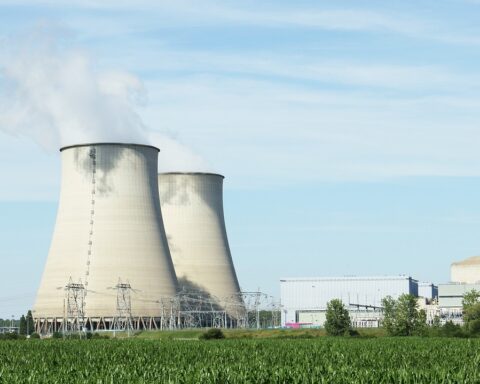The U.S Department of Energy (DOE) has announced a $42 million program to create three research-and-development hubs that will focus on advancing inertial confinement fusion energy (IFE) as a potential new source of clean energy.
Nuclear fusion, the process that powers the sun, occurs when two light atomic nuclei combine to form a single heavier one while releasing massive amounts of energy. IFE is an approach to fusion that uses lasers or other technologies to compress and heat high-density plasmas.
The process contrasts with the one used by current nuclear power plants, which produce energy by splitting atoms in elements like uranium. IFE occurs without carbon emission, making it a potentially viable source of clean energy.
The hubs will be led by researchers at Colorado State University, the University of Rochester and Lawrence Livermore National Laboratory (LLNL) — a government-owned, contractor-operated lab.
The move is being made to advance the White House’s 10-year goal of demonstrating the feasibility of different types of fusion power plants.
“Harnessing fusion energy is one of the greatest scientific and technological challenges of the 21st Century,” U.S. Secretary of Energy Jennifer M. Granholm said in a statement. “We now have the confidence that it’s not only possible, but probable, that fusion energy can be a reality. The scientists in these hubs will be the vanguard of game-changing and planet-saving breakthroughs.”
Scientists have been working to achieve a self-sustaining nuclear fusion reaction in laboratories since the 1950s.
The idea of IFE as a clean energy source evolved from concept to possibility in 2022 when a team at LLNL achieved fusion ignition for the first time, proving that creating energy from fusion is possible.
Fusion ignition refers to the moment when the energy from a controlled fusion reaction outstrips the rate at which X-ray radiation losses and electron conduction cool the implosion: as much or more energy outthan in.
“This breakthrough supports the lab’s stockpile stewardship mission and could lead to a new source of boundless clean energy for the world,” LLNL said in a statement.
A STAR is born
Projects funded by the new DOE program — known as Inertial Fusion Energy Science and Technology Accelerated Research (IFE-STAR) — will involve a partnership between the DOE’s national laboratories, academia, and industry leaders.
IFE-STAR projects are intended to create high-gain target designs; high-efficiency lasers at high repetition rates; and IFE-relevant fusion target manufacturing, tracking, and engagement, the DOE said.
A major component of the funded projects is stewardship of the inertial fusion ecosystem, including the development of an inclusive and diverse workforce, the DOE said.
The projects were selected by competitive peer review under the DOE Funding Opportunity Announcement for Inertial Fusion Energy Science and Technology Accelerated Research.
Projects will last up to four years with total funding of $42 million, including $9 million in Fiscal Year 2023 and $33 million in following years contingent on congressional appropriations.
The Projects
LLNL’s Innovation and Reactor hub is getting a four-year, 16 million grant to lead the charge in advancing IFE technology.
The hub — dubbed “STARFIRE” — will focus on developing designs capable of producing energy inexpensively and efficiently. It will also work to develop laser technology guided through IFE-plant framework.
Additionally, the project will begin developing the IFE workforce through partnerships with universities.
The hub has more collaborators than the other two, including seven universities, four U.S. national labs, one international lab, three commercial entities, a philanthropic organization and three private IFE companies.
The Inertial Fusion Science and Technology Hub, also known as RISE, will be headquartered at Colorado State University.
RISE will receive $16 million in funding over the next four years.
Carmen Menoni, University Distinguished Professor of Electrical and Computer Engineering, serves as director of the new hub. Her team will use laser technologies to harness the potential of fusion for abundant clean energy.
Colorado State University and the DOE’s Stanford Linear Accelerator Center (SLAC) at Stanford University will lead the hub. They are working in partnership with experts from the University of Illinois, Cornell University, Texas A&M, Los Alamos National Laboratory, Naval Research Laboratory and three companies: Marvel Fusion, Xcimer Energy, and General Atomics.
Experiments at CSU will use the university’s ALEPH laser — a high repetition rate, petawatt-class laser system to be upgraded to two petawatts (one petawatt equals 1 million billion watts). ALEPH was built in-house under the leadership of CSU Professor Jorge Rocca, in partnership with university experts in ultra-intense laser interaction.
“We envision the hub to become a center of excellence for IFE science and technology and a magnet to attract talent and develop workforce to support DOE’s mission in IFE,” Menoni said. “We are thrilled to partner with a world-class team of experts who are committed to making IFE a commercial reality.”
A four-year, $10-million award went to the University of Rochester’s Laboratory for Laser Energetics (LLE) to lead a hub on laser-plasma interaction research.
They are working in partnership with Ergodic LLC, University of California–Los Angeles, University of Nebraska–Lincoln and Xcimer Energy.
The hub — named IFE-COLoR, for Inertial Fusion Energy-Consortium on LPI (laser-plasma interaction) Research — will test a new broadband long-pulse laser that would fire directly on hydrogen fuel to support a direct-drive IFE system.
A challenge for an inertial fusion energy system is efficiently coupling energy from the laser driver onto the fusion target, and the main culprit is laser-plasma instabilities at fusion conditions, the University of Rochester said. Broadband and long-pulse lasers are predicted to mitigate laser-plasma instabilities.
“From the initial experiments, scientists have wanted to use lasers with lots of colors (i.e., a large bandwidth) to mitigate laser-plasma instabilities,” said Dustin Froula, the IFE-COLoR principal investigator and the division director of plasma and ultrafast laser science and engineering at LLE. “It has taken more than 50 years to develop the technologies and science that will enable experiments to demonstrate the laser-plasma science that will underpin a future direct-drive inertial fusion energy system.”
LLE — established in 1970 — is the largest DOE university-based research program in the nation and operates the Omega Laser Facility, the largest laser in the world at an academic institution, under a recently renewed cooperative agreement with the National Nuclear Security Administration.













